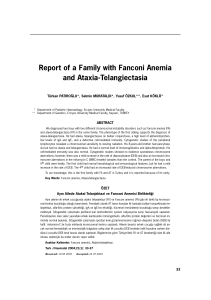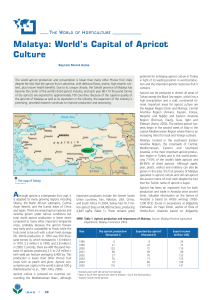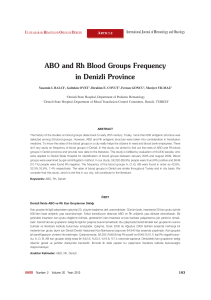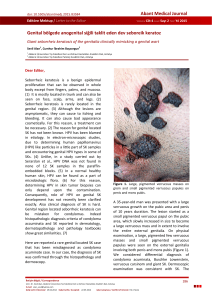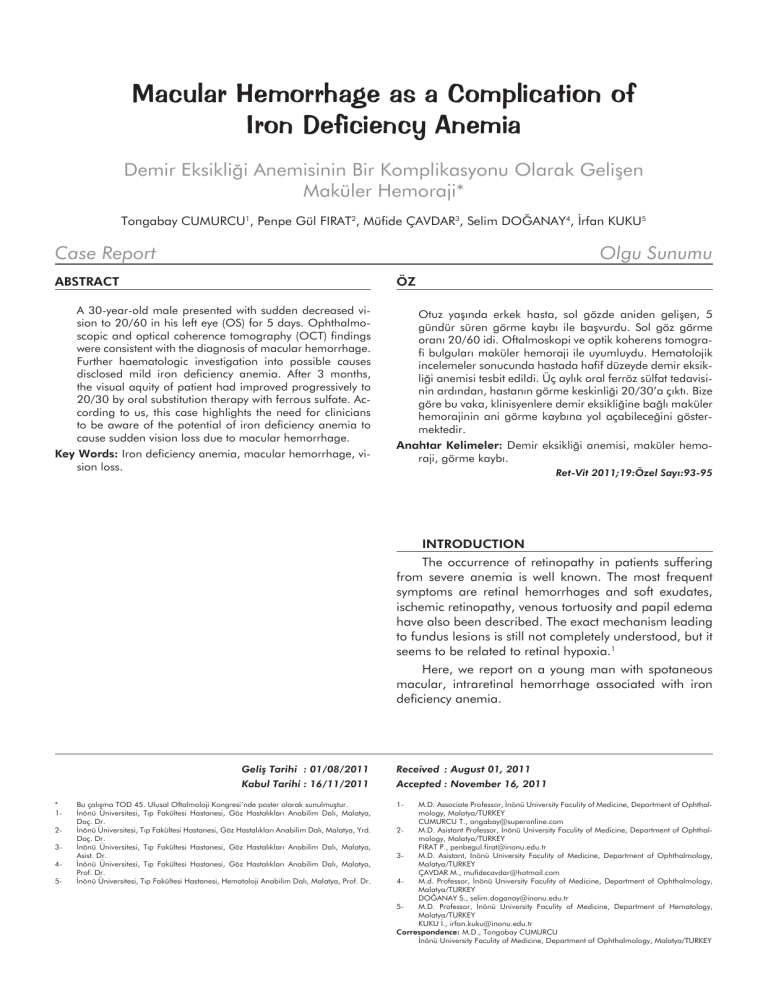
Macular Hemorrhage as a Complication of
Iron Deficiency Anemia
Demir Eksikliği Anemisinin Bir Komplikasyonu Olarak Gelişen
Maküler Hemoraji*
Tongabay CUMURCU1, Penpe Gül FIRAT2, Müfide ÇAVDAR3, Selim DOĞANAY4, İrfan KUKU5
Case Report
Olgu Sunumu
ABSTRACT
ÖZ
A 30-year-old male presented with sudden decreased vision to 20/60 in his left eye (OS) for 5 days. Ophthalmoscopic and optical coherence tomography (OCT) findings
were consistent with the diagnosis of macular hemorrhage.
Further haematologic investigation into possible causes
disclosed mild iron deficiency anemia. After 3 months,
the visual aquity of patient had improved progressively to
20/30 by oral substitution therapy with ferrous sulfate. According to us, this case highlights the need for clinicians
to be aware of the potential of iron deficiency anemia to
cause sudden vision loss due to macular hemorrhage.
Key Words: Iron deficiency anemia, macular hemorrhage, vision loss.
Otuz yaşında erkek hasta, sol gözde aniden gelişen, 5
gündür süren görme kaybı ile başvurdu. Sol göz görme
oranı 20/60 idi. Oftalmoskopi ve optik koherens tomografi bulguları maküler hemoraji ile uyumluydu. Hematolojik
incelemeler sonucunda hastada hafif düzeyde demir eksikliği anemisi tesbit edildi. Üç aylık oral ferröz sülfat tedavisinin ardından, hastanın görme keskinliği 20/30’a çıktı. Bize
göre bu vaka, klinisyenlere demir eksikliğine bağlı maküler
hemorajinin ani görme kaybına yol açabileceğini göstermektedir.
Anahtar Kelimeler: Demir eksikliği anemisi, maküler hemoraji, görme kaybı.
Ret-Vit 2011;19:Özel Sayı:93-95
INTRODUCTION
The occurrence of retinopathy in patients suffering
from severe anemia is well known. The most frequent
symptoms are retinal hemorrhages and soft exudates,
ischemic retinopathy, venous tortuosity and papil edema
have also been described. The exact mechanism leading
to fundus lesions is still not completely understood, but it
seems to be related to retinal hypoxia.1
Here, we report on a young man with spotaneous
macular, intraretinal hemorrhage associated with iron
deficiency anemia.
Geliþ Tarihi : 01/08/2011
Received : August 01, 2011
Kabul Tarihi: 16/11/2011
Accepted: November 16, 2011
*
1-
2-
3-
4-
5-
Bu çalışma TOD 45. Ulusal Oftalmoloji Kongresi’nde poster olarak sunulmuştur.
İnönü Üniversitesi, Tıp Fakültesi Hastanesi, Göz Hastalıkları Anabilim Dalı, Malatya,
Doç. Dr.
İnönü Üniversitesi, Tıp Fakültesi Hastanesi, Göz Hastalıkları Anabilim Dalı, Malatya, Yrd.
Doç. Dr.
İnönü Üniversitesi, Tıp Fakültesi Hastanesi, Göz Hastalıkları Anabilim Dalı, Malatya,
Asist. Dr.
İnönü Üniversitesi, Tıp Fakültesi Hastanesi, Göz Hastalıkları Anabilim Dalı, Malatya,
Prof. Dr.
İnönü Üniversitesi, Tıp Fakültesi Hastanesi, Hematoloji Anabilim Dalı, Malatya, Prof. Dr.
1-
M.D. Associate Professor, İnönü University Faculity of Medicine, Department of Ophthalmology, Malatya/TURKEY
CUMURCU T., [email protected]
2-
M.D. Asistant Professor, İnönü University Faculity of Medicine, Department of Ophthalmology, Malatya/TURKEY
FIRAT P., [email protected]
3-
M.D. Asistant, İnönü University Faculity of Medicine, Department of Ophthalmology,
Malatya/TURKEY
ÇAVDAR M., [email protected]
4-
M.d. Professor, İnönü University Faculity of Medicine, Department of Ophthalmology,
Malatya/TURKEY
DOĞANAY S., [email protected]
5-
M.D. Professor, İnönü University Faculity of Medicine, Department of Hematology,
Malatya/TURKEY
KUKU İ., [email protected]
Correspondence: M.D., Tongabay CUMURCU
İnönü University Faculity of Medicine, Department of Ophthalmology, Malatya/TURKEY
94
Macular Hemorrhage as a Complication of Iron Deficiency Anemia
There was no vitreous inflammation or hemorrhage,
venous dilatation or tortuosity, retinal neovascularization.
The diagnosis of spontaneous macular hemorrhage was
made and the patient was started on a comprehensive
medical and ophthalmological check-up. Bilateral ocular
ultrasonography was normal. OCT was revealed intraretinal hemorhage in the macula on his left eye (Figure
2). The patient’s history was negative for arterial hypertension, diabetes mellitus, atherosclerosis, hyperlipidemia,
ocular disease, cigarette or drug abuse.
Figure 1: Macular hemorrhage in the left eye.
CASE REPORT
A 30-year-old male presented with sudden, painless
decreased vision in his left eye (OS) for 5 days. There was
no headache or claudication. On ophthalmic examination, visual aquity was 20/60 OS and 20/20 OD. Anterior segment examination and intraocular pressure were
unremarkable in both eyes. Dilated fundus examination
of his left eye revealed a fresh, small retinal hemorrhage
in the macula (Figure 1), whereas his uneffected eye was
unremarkable.
Figure 2: OCT appearance of macular hemorrhage in the left eye.
In addition our patient’s history was negative for valsalva maneuvers such as vomitting or strain. Morover, he
had never undergone a surgical procedure. Hematology
and internal medicine departments performed necessary
examination and tests for patient. A complete blood count
showed iron deficiency anemia with haemoglobin of 9.4
g/dL, haematocrit of 30.3%, MCH of 20.9 pg, MCHC of
31.7 g/dL, MCV 66 fL, serum Fe of 15 µg/dL, Fe binding capacity (UIBC) of >500 µg/dL and ferritin of 11.5
ng/ml. C-reactive proteine and erythrocyte sedimentation rate were normal. Also, the periferic smear result was
support iron deficiency anemia. The following laboratory
test results were also negative or normal: platelet count,
prothrombin time (PT), fibrinogen, partial thromboplastin
time (PTT), bleeding time, tissue plasminogen activator (tPA), von Willebrant factor antigen and factor VIII activity
and antigen.
Ret-Vit 2011;19:Özel Sayı:93-95
In patient’s systemic examination and laboratory
tests there were no any abnormal finding except iron deficiency anemia. The patient was started on iron 100x2
mg/day as oral tablets. Subsequently, visual aquity in the
effected eye improved to 20/30 OS after 3 months.
DISCUSSION
The anemia has been reported as an important risk
factor for developing retinopathy in many case series,
with a prevalence of 20-28.3%.2-4 Carraro et al. have
reported to fundus lesions in 9 (24%) of 37 patients with
iron deficiency anemia.4 Therefore to the best our knowledge, there is no report about macular hemorrhage associated with iron deficiency anemia.
The retinopathy was described due to several types
of anemia such as iron deficiency anemia, aplastic anemia, sickle cell anemia, beta-thalassemia, pernicious
anemia, drug-induced anemia.4-9 We diagnosed iron
deficiency anemia in our case in light of the foregoing.
Although, mainly central or branch retinal vein
occlusions have been reported due to iron deficiency
anemia, we have not find a case related with macular
hemorrhage.10-11 Furthermore, vision loss following nonophthalmic surgery is an increasingly recognized complication. Two risk factors commonly associated with visual loss in this setting are intraoperative blood loss and
hypotension.12 But, there is no history of ophthalmic or
non-ophthalmic surgery in our case.
The incidence of blood component abnormalities is
high in young patients who rarely have systemic hypertension or arterial sclerosis. Retinochoroidal circulation
may be disturbed in patients with abnormalities of blood
components as in our case.1-3
In conclusion, this case highlights the need for clinicians to be aware of the potential of iron deficiency
anemia to cause sudden vision loss due to macular hemorrhage.
Cumurcu et al.
95
REFERENCES/KAYNAKLAR
1.
Loewenstein JI.: Retinopathy associated with blood anomalies. In:
Jakobieck, F, ed. Clinical Ophthalmology. Revised edn. Philadelphia: J.B. Lippincott Company. 1995;3:995-1000.
2. Aiesen ML, Bacon BR, Goodman AM, et al.: Retinal abnormalities
associated with anemia. Arch Ophthalmol. 1983;101:1049-1052.
3. Merin S, Freund M.: Retinopathy in severe anemia. Am J Ophthalmol. 1968;66:1102-1106.
4. Carraro MC, Rossetti L, Gerli GC.: Prevalence of retinopathy in
patients with anemia or thrombocytopenia. Eur J Haematol.
2001;67:238-244.
5. Erdurmus M, Celik L, Kaynak T, ve ark.: Spontaneous devalopment
of bilateral preretinal hemorrhages in aplastic anemia. Ret-Vit.
2005;13:219-221.
6. Davis SJ, Safar A.: Images in clinical medicine. Retinal arteriolar
occlusions during a sickle cell crisis. N Engl J Med. 2010;362:536.
7. Aessopos A, Floudas CS, Kati M, et al.: Loss of vision associated
with angioid streaks in beta-thalassemia intermedia. Int J Hematol.
2008;87:35-38.
8. Gupta V, Bremner FD, Telfer P.: Bilateral retinal haemorrhages:
an unusual presentation of pernicious anaemia. Br J Haematol.
2001;112:831.
9. Belfort RN, Fernandes BF, Romano A, et al.: Bilateral macular hemorrhage as a complication of drug-induced anemia: a case report.
J Med Case Reports. 2009;3:16.
10. Imai E, Kunikata H, Udono T, et al.: Branch retinal artery occlusion:
a complication of iron-deficiency anemia in a young adult with a
rectal carcinoid. Tohoku J Exp Med. 2004;203:141-144.
11. Kacer B, Hattenbach LO, Hörle S, et al.: Central retinal vein occlusion and nonarteritic ischemic optic neuropathy in 2 patients with
mild iron deficiency anemia. Ophthalmologica. 2001;215:128-131.
12. Williams EL.: Postoperative bilndness. Anesthesiol Clin N Am.
2002;20:605-622.

